MCSC 2024 Symposium: Bridging Academia and Industry to Scale Urgent Climate Solutions
January 29, 2025
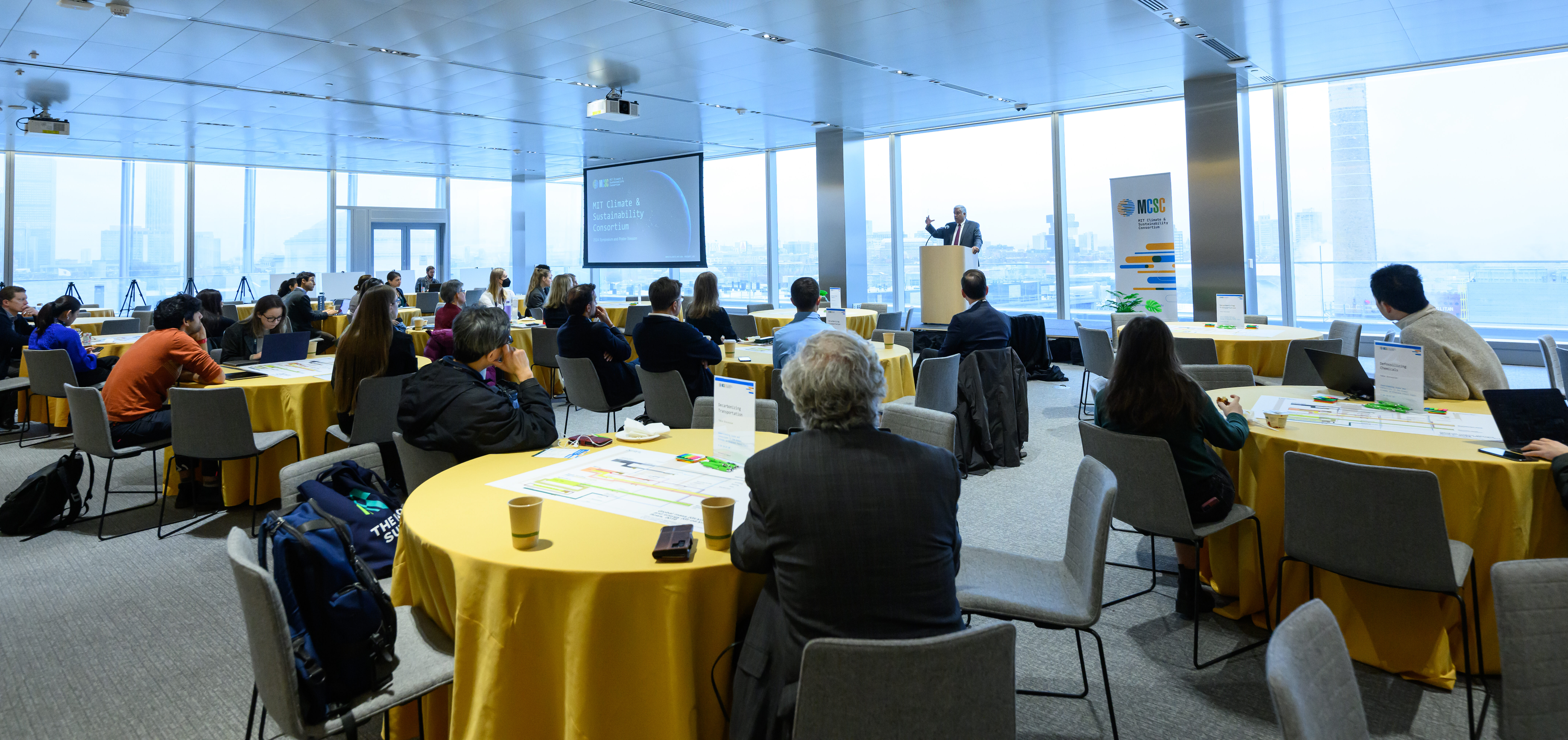
Dean Anantha Chandrakasan addresses attendees at MCSC’s Annual Symposium on Nov. 22, 2024
The MCSC’s 2024 annual symposium welcomed industry members and the MIT community to discuss the efficacy of current methods to meet decarbonization objectives and brainstorm how to leverage solutions for greater climate impact. The two-day event, held at MIT in November, exemplified the energy, ideas, and innovations that can be sparked when companies, across sectors, and academia join forces.
“We are fortunate to cross-pollinate with some of the world’s largest industry leaders as we work together towards our sustainability goals,” said Anantha P. Chandrakasan, dean of the MIT School of Engineering, MIT’s Chief Innovation and Strategic Officer, Vannevar Bush Professor of Electrical Engineering and Computer Science, and chair of the MCSC, in opening remarks.
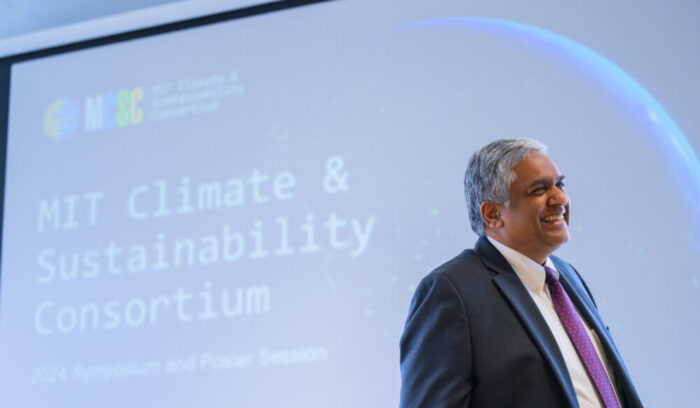
Dean Anantha Chandrakasan at MCSC’s 2024 Annual Symposium. Photo by Gretchen Ertl.
“Combining the deep insights of our member companies with the tremendous talents of the MIT community is how we come up with and deploy solutions to problems that cut across sectors.”
Positioned as a bridge between academia and industry, the MCSC drives urgently needed solutions. Sessions were strategically crafted by the MCSC’s Impact Fellows to be relevant to attendees’ interests and needs, to spark conversation about best practices and shared challenges from various industries, and chart practical next steps.
Exploring Opportunities with MITEI to Decarbonize Thermal Processes and Heavy-duty Transportation
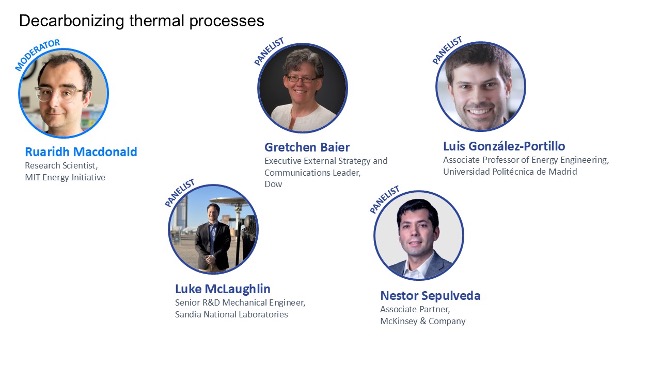
Panelists for the Decarbonizing Thermal Processes session. Graphic courtesy of MITEI.
The event began with two sessions held in conjunction with the MIT Energy Initiative Future Energy Systems Center, featuring expert speakers from MIT, industry, government, and national labs. The first session on decarbonizing heat generation—a process that has typically relied on fossil fuels because of the high temperatures required—explored a range of solutions being considered by industry. These included emerging thermal storage technologies like Redoxblox, a thermochemical energy storage system that boasts higher energy density than lithium-ion at a lower cost. Discussion centered on integration and technical challenges in electrifying thermal processes due to hidden costs and complexities, as well as the need for more compact systems, phase change materials, ways to increase efficiency and lower cost, and actionable direction for industry members.
Decarbonization opportunities for the heavy duty transportation industry is a crucial driver of the economy that is responsible for ~25% of global greenhouse gas emissions. Jared Hightower of Commercial at ANGI Energy Systems, a Vontier company, discussed a multi-fuel future for trucking and stressed the importance of infrastructure for gaseous fuels like hydrogen and renewable natural gas. Jennifer Morris, of the MIT Center for Sustainability Science and Strategy and MIT Energy Initiative shared research results on a promising opportunity for biofuels to contribute to the industry through the conversion of grasslands and pasture to dedicated energy crops.
John Pendray, Senior Technical Advisor-Technology Development at Cummins, highlighted the opportunity to improve biomass-to-biofuel conversion efficiency by electrifying the Fischer-Tropsch process, given continuing reductions in costs of low-carbon renewable electricity. James Szybist, Section Head of Propulsion Science at Oak Ridge National Laboratory, noted that biomass suffers from reverse economies of scale, arguing that fuel options will be most important for ships, rail, and aviation.
Poster Session
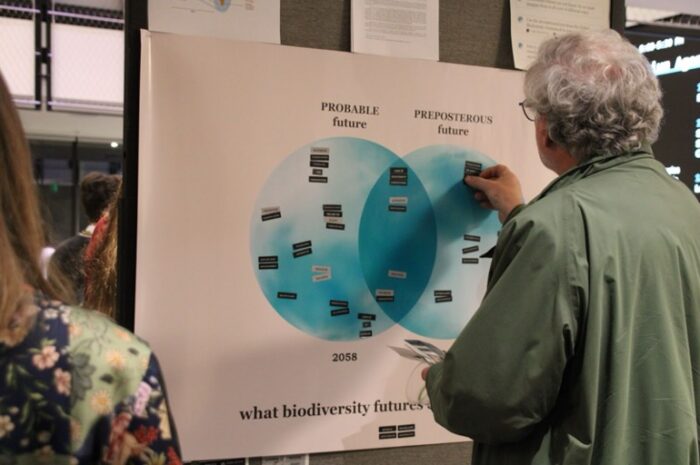
The first day concluded with a poster session at the Tina and Hamid Moghadam Building, featuring the work of MCSC Impact Fellows, MCSC seed awardees, and others in the MIT community.
Outcomes from Industry-academia Partnerships
The second day of events began with a keynote speech by MCSC Associate Director Caitlin Mueller, Associate Professor of Civil and Environmental Engineering and Architecture at MIT, who presented a promising strategy for concrete reuse, Pixelframe, that aligns with the MCSC’s focus area on circularity as well as the priorities of several member companies.
“Our research has confirmed that circularity can work technically and logistically at the scale of the built environment,” said Mueller. “It requires design for disassembly, reconfiguration, versatility and upfront carbon and cost efficiency, which we’ve demonstrated here.”

Visualization of the Pixelframe structural system used to construct a gallery.
Mueller leads the Digital Structures research group, which focuses on new computational design and digital fabrication methods for innovative high-performance buildings and structures that empower a more sustainable and equitable future. The system they developed balances material efficiency, adaptive reuse, and versatility through “a smart kit of parts” made up of individual units called Pixels and is designed to accommodate a wide range of applications from housing to warehouses. In recent estimates, the carbon efficiency of Pixelframe reports ~80% reduction of embodied carbon from typical concrete construction, with carbon emissions further reduced by half when reused over multiple building lifetimes, as intended.
“We wanted to create a system that is beautiful, that captures the imagination of the occupants and owners, to transition from this idea of building materials as future garbage to a world where they are precious things with aesthetic value, as a way of encouraging reuse,” said Mueller, speaking to additional considerations for carbon reduction strategies in the built environment.
Understanding Scale & Connections in the Global Economy to Displace Fossil Fuels
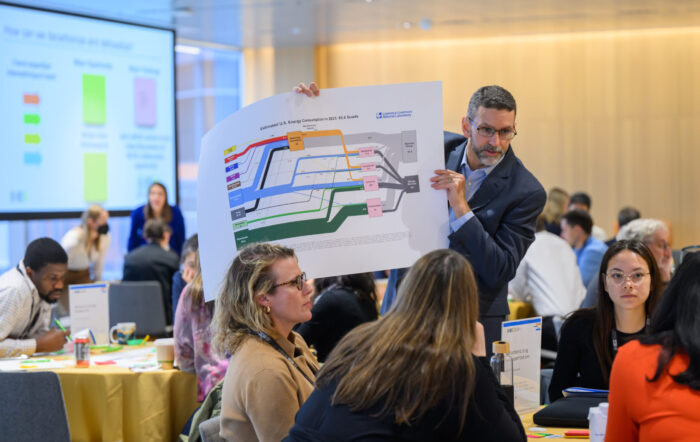
MCSC Executive Director Jeremy Gregory interacts with a diagram depicting materials and energy flows. Photo by Gretchen Ertl.
Understanding the scale of the physical economy—the flow of materials and energy between sectors—and its connections is necessary to achieve true decarbonization without shifting burdens. A workshop led by Katie Daehn, Research Scientist in the Materials Research Laboratory, and MCSC Impact Fellows Danika MacDonell and Mary Kate Mitchell Lane, centered on an interactive visualization to explore major flows in the global economy and how this framework can be used in decision-making to displace fossil fuels.
Participants were pushed to think rigorously and design a fossil-fuel and carbon-free future in small group discussions. Groups that focused on the transportation sector noted a significant opportunity to create industrial clusters for decarbonization, along with better policy frameworks to align actors and incentives. They also observed that consumer willingness to embrace change may depend on education and incentivization.
When it comes to defossilizing the petrochemical sector, participants noted an opportunity to increase circularity of hard-to-recycle polyethylene. They also anticipate challenges in having to meet an increased demand for ammonia and manage its explosive capabilities. Other emergent areas of need and opportunity included ways to sustain the increasing energy needs of data centers, and incentivizing farmers away from burning residue in order to use that material flow as a carbon sink.
Social Dimensions of Climate and Sustainability
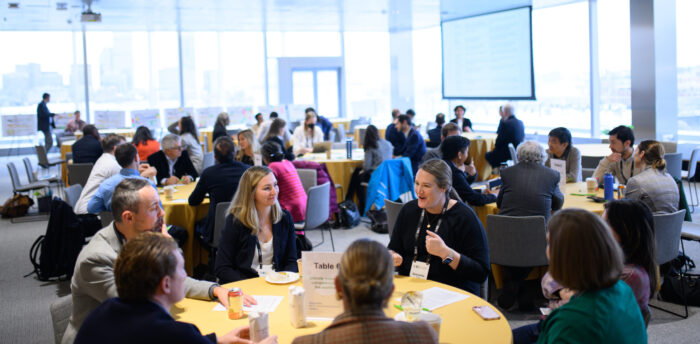
The broad range of round table topics included climate justice, designing people-first sustainability solutions, bottom-up data collection, traditional ecological knowledge for climate adaptation, the equitable resilience framework, valuing the future, changing financial stakeholder demands, reputational risk, and the promises and pitfalls of net-zero for institutions. Photo by Gretchen Ertl.
Participants engaged in two rounds of peer-to-peer dialogue, led by nine academic experts from social sciences, planning, and community implementation. Discussion highlights from the session include carbon colonialism and the Africa Carbon Markets Initiative, an MIT-initiated molten salt heat bank project in Mongolia, the relationship between biodiversity restoration action and corporate reporting, opposing strategies for publicizing corporate sustainability efforts, and the need to better understand foundational social concepts when transferring lab work into community action.
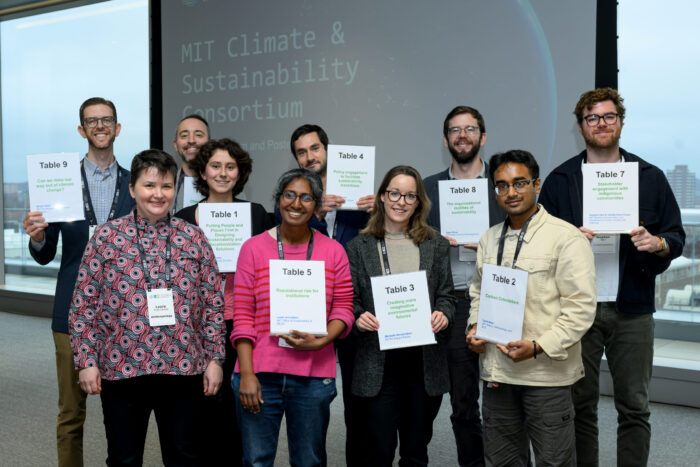
Table leaders for the round session were Iselle Barrios, MCSC Climate Scholar; Tarek Meah, MIT History Anthropology, Science, Technology, and Society (HASTS); MCSC Impact Fellows Michelle Westerlaken and Laurent Lioté; Leela Velautham, MCSC; Chris Rabe, MIT Environmental Solutions Initiative (ESI); Stephen Hart and Janelle Knox-Hayes, MIT Resilient Communities Lab; Eppa Rixey, MIT Sloan School of Management; and Scott Odell, MIT ESI; moderated by Laura Frye-Levine, MIT Department of Anthropology.
Advanced Modeling for Climate Risk
As the climate changes, system risk evaluations—of buildings, infrastructure, human health, and ecosystems—will require new modeling approaches that incorporate climate projections rather than relying on historical data.
A session on the latest advances in advanced climate risk modeling explored the gap between current modeling capabilities and industry needs, and discussed how this gap might be narrowed, with additional industry perspectives from Campbell Watson, Senior Research Scientist, IBM. Two MIT Climate Grand Challenge projects were highlighted: Bringing computation to the climate challenge (BC3), represented by project co-leader Raffaele Ferrari, the Cecil and Ida Green Professor of Oceanography in the Department of Earth, Atmospheric and Planetary Sciences (EAPS) at MIT; and Preparing for a new world of weather and climate extremes, represented by Sai Ravela, Principal Research Scientist in MIT EAPS. The panel was moderated by Kevin Huang, Research Scientist in MIT’s Department of Materials Science and Engineering and member of the BC3 team.
Much discussion centered on the threshold for decision-grade data and how and who determines that delineation. Panelists also agreed that there is a need to better assess and communicate uncertainty in models when presenting scenarios for decision making. They also remarked on the important opportunity for climate modeling to combine physics-based approaches with machine learning approaches, emphasizing that stakeholders responsible for deciding climate change policy should be connected to tools that allow emulation of future climate scenarios.
Building biodiversity strategies through environmental data
Biodiversity is a non-fungible resource that forms the foundation of global value chains. Many efforts are underway to increase understanding of ecosystems through measurement and modeling, but data collection is not enough.
“Efforts must go beyond measurement and reporting to identifying opportunities for nature-positive contributions,” said panelist Lydia Zemke, a Fellow at the Davies Lab, Harvard University, and Senior Advisor to EarthAcre Inc. in a session on developing strategies for biodiversity preservation and restoration through technological innovation.
Zemke noted that actionable corporate strategies can include harm reduction measures, such as minimizing deforestation and prioritizing sustainable sourcing, as well as direct nature-positive actions, such as conservation and restoration efforts. In turn, corporations stand to benefit from enhanced brand reputation, social license, and access to green finance and sustainability-linked loans.
MCSC Impact Fellows Amanda Bischoff and Michelle Westerlaken moderated the panel that also included Campbell Watson, Senior Research Scientist, IBM; Benedetto Marelli, Associate Professor, MIT Department of Civil and Environmental Engineering; and Neda Trifkovic, Assistant Professor, Department of Economics, University of Copenhagen.
Panelists discussed how technologies like geospatial mapping and modeling, acoustic sensing, biodiversity reporting tools, and bioengineering can both create new knowledge as well as pose new challenges at different scales. They noted that there is a significant opportunity for corporate engagement as the market realizes that multiple data sets are needed for biodiversity measurement.
Catalyzing Climate Action at MIT
The symposium closed with a stimulating conversation between leaders of the Climate Project, a whole-of-MIT initiative that aims to accelerate interdisciplinary research and implementation.
“What keeps me up at night is the fact that we need do so much more,” said Miho Mazereeuw, Associate Professor in the MIT Department of Architecture and Mission Director of Empowering Frontline Communities, whose mission aims to co-create technical solutions for communicating risk and develop housing and adaptation strategies in regions affected by natural disasters. “But I’m inspired by the people in the communities who are already doing this work, which helps me better understand how we can contribute.”
MCSC Director Desiree Plata, Associate Professor in the MIT Department of Civil and Environmental Engineering, moderated the panel that also included Christopher Knittel, Associate Dean for Climate and Sustainability, George P. Shultz Professor of Applied Economics at the MIT Sloan School of Management, and Mission Director of Inventing New Policy Approaches; and Elsa Olivetti, Jerry McAfee (1940) Professor in the MIT Department of Materials Science and Engineering, Mission Director of Decarbonizing Energy and Industry, and MCSC Strategic Advisor.
Panelists discussed the need for tools that policymakers can use to combat climate change, noting that an overview of policy efforts in the climate space across MIT will be beneficial to influence policy making. They also pointed to efforts in sustainable computing and computing for sustainability, such as using AI to analyze data towards improving the energy grid. The mission leaders ended by emphasizing that the impact of technical solutions on both policy and communities must be considered simultaneously and that the Climate Project is well-suited to hold that space.
Plata’s closing remarks thanked attendees as well as MCSC staff, referencing a quote by President John F. Kennedy: “One person can make a difference, and everyone should try.”
“MCSC represents what can happen through synergistic partnerships of incredibly dedicated individuals,” said Plata, encapsulating the event’s unifying theme of harnessing the contributions of many individuals and industries to magnify impact and drive sustainability solutions. “Each of you in this room is proof of this reality.”
